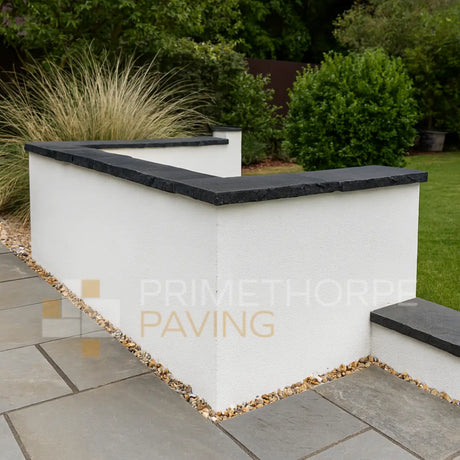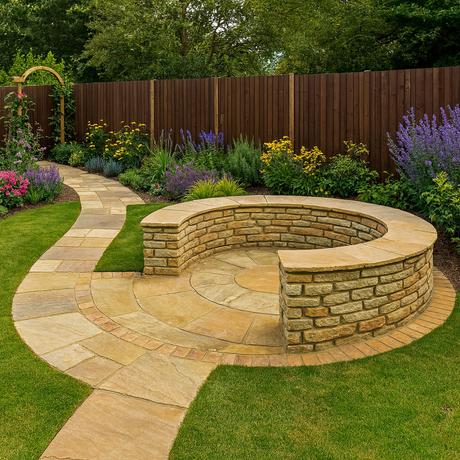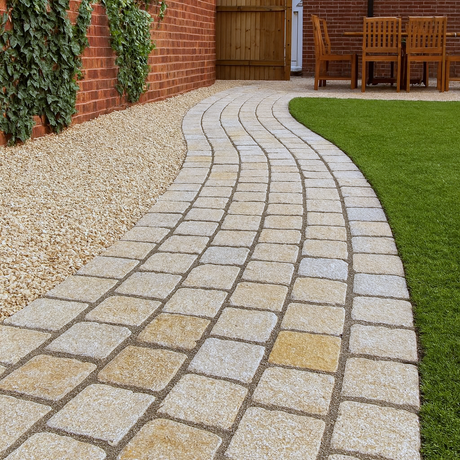When it comes to a paved patio area, there are two main choices. Do you go for natural stone paving slabs or cement paving slabs? There are a lot of differences between to two, not just the materials they are made from. In this blog post we help you compare natural stone paving and cement paving so you can choose the best for your garden.
Is There A Difference Between Natural Stone Paving And Cement Paving?
Apart from the material, you’d be forgiven for thinking there aren’t many other differences between the two types of pavers. Sometimes they can even look visually similar, and both are readily available thanks to the ease of shipping natural stone these days. Both types can be used for patio areas, garden paths and driveways too, but ultimately the final look can be dramatically different depending on which option you go for. How do you want your final space to look? Natural stones look more rustic for obvious reasons and are often better suited to high traffic areas. But if you wanted consistency and regularity for a more modern space, then maybe a manufactured slab is the way to go. Council paving slabs are a common option here. Lets look at a few more differences between the two types to hopefully shed some light on which might be best for your project.
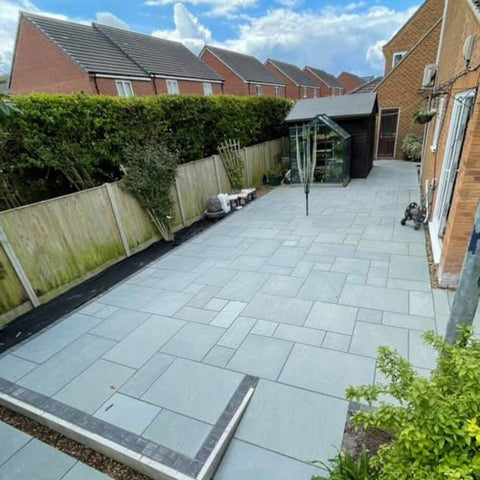
Cost Differences Between Natural Stone Paving & Cement Paving Slabs
In general, the basic concrete paving is the cheaper option. However, there are some premium concrete paving products that will come in a lot more expensive than natural stone, so don't be fooled into assuming concrete slabs are what you need if you are on a budget. These days, due to the availability and effective supply chain for imported natural stone, the price has often been driven down to where you can use natural stone on a budget. It’s a good idea to check out the full range of concrete paving and natural stone paving first, then compare the prices when you have found the paving style that you like.
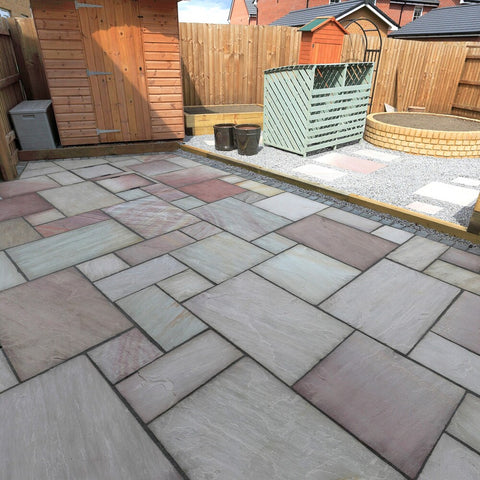
Installation Differences Between Natural Stone & Concrete Pavers
While both paving options are installed in the same way, natural stone paving can take longer to install. Concrete stones have been cast in a factory, so are completely uniform. This means concrete can be laid quickly, whereas natural stone can have small imperfections in sizing which need to be accounted for, so it can slow down installation in order the guarantee a good job.
The pros of having a uniform concrete slab is obvious, but the downside is having a patio which isn't unique or different. You see it often on new build properties, each house on the street has the exact same patio. This is because they are easier to install, so it makes sense if you are looking to wrap the new build up as quickly as possible. However, if you are looking for something unique and one-of-a-kind, then natural stone is a difference maker. The lack of uniformity - while it slows the job down - results in an eye-catching patio which sets your garden apart from anyone else's.
It's all worth considering. If you want to get the job installed quickly, then maybe concrete is the way forward - but if you want something unique and aren't in a massive rush, then natural stone is worth it.
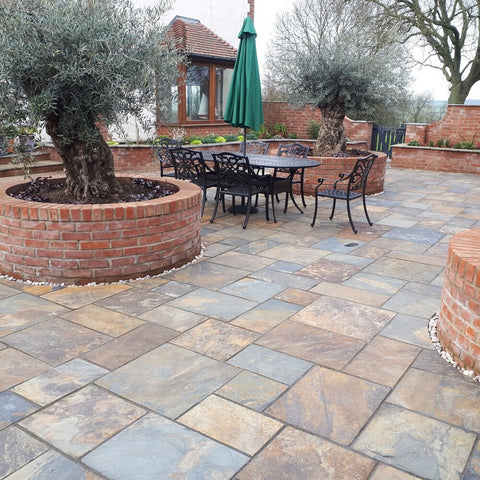
Which Is Stronger? Natural Stone or Concrete Paving
Concrete paving is not the most durable material, especially coloured concrete. Concrete slabs eventually become brittle - as a manufactured product, they do have a shelf life. On average, most manufactured tiles come with a lifespan of around 10 years before they need replacing. So they're not going to disappear overnight, but they will reach the end of their life eventually. This can be seen by cracks in the cement paving as the subtle ground movements become too much for the aged stone. Additionally, any dyes used in colouring concrete slabs have a very limited lifespan - after a few years, vibrant red/orange slabs will fade to a feint colour, and after many years will be all but gone, leaving you with a grey, dull slab with no dye remaining.
Stone paving slabs are much more hard-wearing and will stay in good condition almost indefinitely if installed to proper standards. They are naturally occurring and have been on earth for millions of years! So they are not going to fail or reach end of life at any point. Even natural stones that have been installed for 50 years will still be very serviceable. Think of Yorkstone, which is over a century old - they are still doing a job over 100 years later. Natural stone will fade with direct exposure to sunlight and the other British elements, but this is the case with any outdoor product and will only add to the charm of the product. They will never fade to a colourless grey like a concrete alternative as they are not dyed, they are are the colour that you see throughout the stone.
The shelf-life and strength of natural stone is incomparable to concrete.
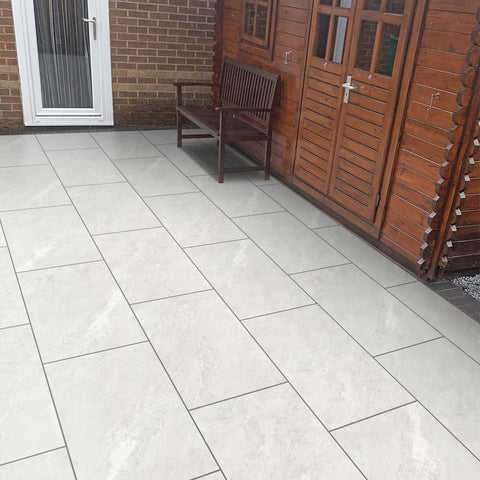
Is one easier to maintain than the other?
One of the biggest considerations when it comes to outdoor paving is maintenance for many homeowners. After all, they are going to take a battering under the UK elements - you need to make sure you know what to expect when your slabs are installed. Some slabs need constant care and attention to keep looking fresh and others need surprisingly little help to stay looking vibrant.
Concrete paving generally needs more maintenance as they age and become more brittle. Cracks can occur as they age and weeds will make light work of growing through them. The manufactured tiles are also more prone to staining too as they are more porous. So if you wanted to protect them long-term, they need extra treatment and care.
Meanwhile, natural stone paving needs less effort to keep it looking good. Staining can be an issue, but the marks are often less obvious as it blends in with the natural colours and shades of the stone. They are longer lasting, so altogether require much less maintenance.

What Type of Paving Slabs Suits Different Garden Styles
Everyone wants their outdoor space to look stylish, but what stylish means to one person isn’t what it means to another. At the end of the day, style comes down to personal preference. Natural stone looks great alongside charming cottages and winding garden paths. It looks great in modern gardens too. Meanwhile, there are a large selection of weathered and contemporary concrete paving slabs available too. It just comes down the look and style you want in your garden, and whether concrete or natural stone suits that style better.





